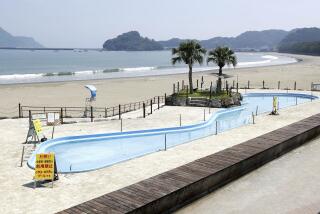Japan prime minister plans rebuilding council
- Share via
Reporting from Tokyo and Los Angeles — After declaring he would convene a national council on rebuilding within 10 days, Japanese Prime Minister Naoto Kan visited the devastated city of Rikuzentakata on Saturday as well as the site serving as the emergency staging headquarters for the Fukushima nuclear crisis.
At the same time, U.S. and Japanese forces launched a massive effort to locate the bodies of more than 16,000 people still listed as missing three weeks after the giant March 11 earthquake and tsunami.
Kan said resolving the crisis at the stricken Fukushima Daiichi nuclear power complex would take a while, but he pledged to do “whatever it takes to win the battle” there and brushed off talk that Tokyo Electric Power Co., which runs the facility, would be nationalized. Tepco, he said, must do what it can to stop radioactive leaks at the plant and compensate those affected by the accident.
The International Atomic Energy Agency once again questioned very high radioactivity readings at the nuclear complex, and U.S. Energy Secretary Steven Chu said that at least one of the reactor fuel cores may have suffered a 70% meltdown.
Tepco had said early Friday that radiation levels in water accumulating in reactor No. 1 had reached 10,000 times permissible levels and were particularly high in radioactive iodine.
But a spokesman for the IAEA said the U.N. agency was suspicious of Tepco’s readings and was looking forward to new results.
Engineers have observed bursts of heat and radiation and even flashes of light at the core, which suggests a “localized criticality,” in which the nuclear chain reaction that normally generates the plant’s power proceeds more rapidly. Such events might occur if fuel melted and accumulated in pools that were not covered by water and thus not cooled.
In a speech Friday morning in Washington, Chu said that as much as 70% of the fuel in the oldest of the plant’s six reactor may be damaged, but he did not provide details.
Before the prime minister’s visit to Rikuzentakata, Chief Cabinet Secretary Yukio Edano was asked at a news conference Friday how long evacuees from the area surrounding the nuclear plant could expect to remain displaced. Residents within 12 miles of the facility were told to leave the area, and residents between 12 and 18 miles away have been advised to do likewise.
“It’s not a situation where we can say we can lift the instructions for evacuation in a matter of weeks,” Edano said.
He wore a business suit to the news conference instead of the blue workman’s jacket that he and many other government officials have worn since the early days of the disaster. Asked about this, he said this was an effort to “take one step forward” toward reconstruction.
Tepco released data showing how much force the Fukushima facility was subjected to in the magnitude 9 earthquake. Reactors No. 2, 3 and 5 sustained forces in excess of what they were designed to withstand, the utility said. Spraying of water continued at reactors 1, 3 and 4 to keep the temperature down.
Tepco also said Friday that it may begin injecting nitrogen gas into the damaged reactors in an effort to prevent hydrogen explosions. Three of the reactors suffered such explosions in the first four days after the earthquake and tsunami shut down the plant and disabled its backup cooling system.
Hydrogen accumulates when the zirconium encasement on the fuel rods heats up, then comes into contact with water. The water oxidizes the zirconium, releasing explosive hydrogen. The nitrogen would dilute the hydrogen and the oxygen necessary to support an explosion.
Meanwhile, about 18,000 Japanese and 7,000 American troops were being mobilized along with Japanese police, firefighters and coast guard members in the air and sea search for corpses along hundreds of miles of Japan’s northeast coast that was devastated by the tsunami.
Tomoko Osawa, a clinical psychologist with the Hyogo Institute for Traumatic Stress, said locating the bodies and bringing them home for funeral services was important in helping the hundreds of thousands of people affected by the disaster to move forward with rebuilding their lives.
Still, she said the condition of any bodies that are found was certain to be difficult for survivors to deal with.
About 11,700 people have been confirmed dead in the disaster.
In a bit of good news, Tepco said that it would not need to implement rolling blackouts planned for Saturday, Sunday and Monday because of the weather forecast and the trend of power demand.
And the government said that beef from a cow in Fukushima prefecture that had originally been found to contain elevated levels of radioactive cesium was cleared in a second test.
Makinen reported from Tokyo and Maugh from Los Angeles.
More to Read
Sign up for Essential California
The most important California stories and recommendations in your inbox every morning.
You may occasionally receive promotional content from the Los Angeles Times.














